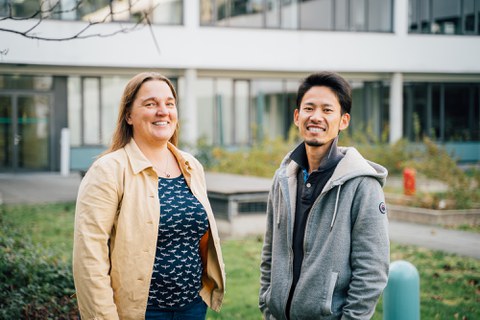Nov 10, 2022
DFG Funding for Interdisciplinary Project on 3D Gene Regulation and Stability in Developing Brain

Dr. Anna Poetsch and Dr. Tomohisa Toda
In a new project, Dr. Anna Poetsch from the Biotechnology Center (BIOTEC) at TU Dresden and National Center for Tumor Diseases (NCT) will combine her expertise in gene regulation and stability with the neurodevelopment know-how of Dr. Tomohisa Toda’s group at the Deutsches Zentrum für Neurodegenerative Erkrankungen (DZNE) and Friedrich-Alexander-Universität Erlangen-Nürnberg (FAU). Together, they want to address the cellular diversity of the brain. The project has been funded by the Priority Program “Spatial Genome Architecture in Development and Disease” of the German Research Foundation (DFG).
The human brain contains many different types of neural cells. Each type is specialized to perform its function. This enormous cellular diversity is what allows the human brain to perform many complex functions.
“Within this project, we want to understand how the brain develops into a myriad of different neural cell types,” says Dr. Poetsch, research group leader at the Biotechnology Center (BIOTEC) of TU Dresden and the National Center for Tumor Diseases (NCT) and a fellow at the Mildred-Scheel Early Career Center (MSNZ).
Interdisciplinary Approach
The new project combines many research areas: molecular biology, neurobiology, developmental biology, and genomics. The Poetsch group feels very comfortable at the intersection of different scientific fields. It combines a deep understanding of molecular and cell biology with cutting-edge computational methods such as machine learning and natural language processing. In recent years, the group developed new tools to research gene regulation and stability.
“Combining molecular biology with functional genomics is the specialty of our group. These highly interdisciplinary projects keep us up to speed with the state-of-the-art mechanistic questions that occupy the field,” explains Dr. Anna Poetsch. “For this project, we are happy to work together with Dr. Tomohisa Toda’s group – the experts in gene regulation and brain development.”
The Influence of Genome Architecture
“Deciphering the genetic code was a huge step forward. However, we now know that there are other layers of information built into the DNA that control how the genetic code is used,” explains Dr. Poetsch. One such layer is the three-dimensional (3D) arrangement of the DNA within the cell.
The way the two-meter-long DNA string is packed into a small nucleus of a cell does not seem to be random. “Nowadays, we have tools at our disposal that allow us to capture a snapshot of genome arrangement within different cells. It seems that every cell type has its complex way of arranging the DNA. This, for example, can create all sorts of loops that allow potentially distant parts of the genome to interact with each other,” explains Dr. Poetsch.
Using a variety of modern molecular biology and computational tools, the two groups will look at the 3D DNA organization of cells from the developing brain. The teams plan to map how the genome is reorganized as the brain grows and the cells become more and more specialized in their function. They will focus on the nuclear pore complex, a structural platform for the 3D DNA organization.
“We are also interested in the consequences of disrupting the correct genome architecture. How much effect is there on gene regulation, the damage in the DNA and the number of mutations that the cell accumulates?” adds Dr. Poetsch.
The team hopes that gaining a better understanding of how the brain develops its crucial cell types can help science address the tragic consequences of incorrect brain development such as pediatric brain tumors or neurodevelopmental disorders.
About SPP 2202 – Spatial Genome Architecture in Development and Disease
SPP 2202 is a DFG Priority Program that funds projects that focus entirely on different aspects of 3D genome architecture. The program addresses how cellular individuality is achieved on a genomic level. The answers could allow people to predict how different cells respond to signaling cues during development or in disease.
More about the projects: https://spp2202.charite.de/en/
